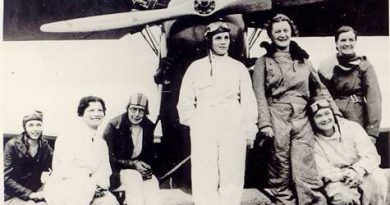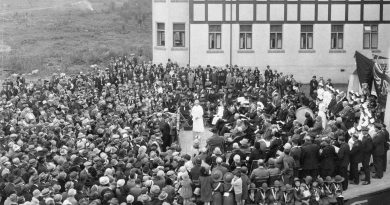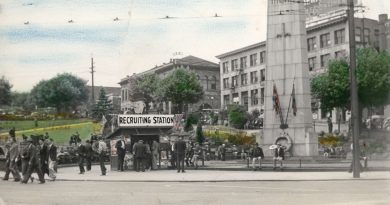1914
Above: C.P.R. station [601 West Cordova Street, later a public transit terminal]
[Image: Vancouver City Archives CVA 677-164]
*****************************************
You’ll note that these years include events listed under “Also in . . .” These are events for which we don’t have a specific date. If YOU know the specific date of an event shown there, please notify us . . . and cite the source! Many thanks!
*****************************************
January 1 The first train of the North Shore Division of the Pacific Great Eastern Railway runs from North Vancouver to Dundarave in West Vancouver. By July 1 the PGE line would be extended to “Whytecliff” station. The interior section started at Squamish and went north; the two sections are not connected. The North Vancouver line was used mostly by residents or holiday-makers rather than for freight.
Also January 1 The last spike marked completion of the Canadian Northern Railway between Port Arthur, Ontario and Vancouver. (The Canadian Northern will eventually be absorbed by the CNR.)
January 2 The first PGE train derailment occurred, on the second day of operation, at 24th Street in West Vancouver.
January 5 Lots “close to beach” are advertised in the Semiahmoo Gazette from $125 to $1,500.
January 30 Movie actor John Ireland was born in Vancouver.
February 1 Recording pioneer Al Reusch was born.
Early February English music hall great Marie Lloyd visited Vancouver. Trouble! The mayor banned her performance. Too risque! (At one point, she lifted her floor-length gown up two inches to reveal a watch on her ankle.)
March 2 A St. David’s Day banquet was given by the Welsh community at Pender Hall.
April 1 William Rathie was born, the first Vancouver mayor (1963-1966) to actually be born in the city.
April 7 Last spike ceremonies marked the completion of the Grand Trunk Pacific Railway, creating a continuous line between Portland, Maine and Prince Rupert, BC.
April 24 Pitt Meadows was incorporated.
April 25 Conductor John Avison was born in Vancouver. He would become the founder of the CBC Chamber Orchestra.
May 8 The first Mothers Day.
Also May 8 Fred Karno’s entertainment troupe from England began a week-long engagement at the Orpheum Theatre (not the present one) at Pender and Howe Streets. Among the performers, a 22-year-old not-yet-famous Charlie Chaplin. Our thanks to site visitor Robert Ingves for this item. And see this site set up by A.J. Marriot. “A.J.” lists every appearance made by Chaplin here: May 8, 1911; October 9, 1911; April 8, 1912; December 30, 1912, and September 8, 1913. Also appearing on the Karno bill that May 8, and on the last two dates cited: Stan Laurel, later to be half of the immortal team Laurel and Hardy.
May 9 From the Coquitlam Star: “The new $50,000 two-storey Terminal Hotel on Busteed Avenue [in Port Coquitlam] will be completed early next week.”
May 19 Back in 1911 a Maine couple, Myrtle and Alex Philip, who had married in 1908 and moved to Vancouver in 1910, realized their dream of opening their own fishing lodge and resort was coming true. They had really been taken with Summit Lake (later named Alta Lake), and travelled there many times. On May 19, 1914 the Philips began to build a lodge on 10 acres they’d bought (for $700) on its northwest shore. Mrs. Philip—the former Myrtle Tapley—was 20, her husband was 29. The Tapley family built the lodge, the Philips ran it.
It took a while back then to get to Alta Lake: a steamship trip to Squamish, an overnight stay in Brackendale and then a two-day trek along the Pemberton Trail on rented packhorses. But 1914 was also the year the Pacific Great Eastern railway reached the area. Soon, the Philip’s Rainbow Lodge, the first fishing/vacation lodge of any size in the Whistler area, became the most popular summer resort west of the Rockies. It was famed for its hospitality, and as many as 100 people could stay there.
They would sell the resort in 1948.
May 23 The ship Komagata Maru arrived and anchored in Burrard Inlet. She carried 376 Indians (12 Hindus, 24 Muslims and 340 Sikhs). Canadian immigration regulations at the time limited immigration from South Asia, and the ship had been chartered by a Sikh businessman specifically to challenge those rules. All but 20 passengers (those who already had resident status) were refused permission to leave the ship. They were also refused food and water, but local supporters managed to supply the men, women and children aboard the ship. The passengers seized control of the vessel. Attempts by local mobs to expel them were met by a hail of Japanese-made bricks from the people aboard. (One of those bricks is preserved at the Vancouver Museum.) Vancouver’s mayor at the time, Truman Baxter, organized an anti-Asian rally, and in June a board of inquiry found all the passengers inadmissible. But without supplies for the return voyage, the ship would not leave. In July, an armed boarding party stormed the ship, but were unable to capture it. Finally, the new Royal Canadian Navy—in its first official task—was called in and the Komagata Maru was forced to steam away with its passengers, back to India.
May 29, 1914 The Empress of Ireland sank in the St. Lawrence River after colliding with the Norwegian collier Storstad. She went down within 15 minutes, with the loss of 840 passengers and 172 crew members. Among the 462 survivors: Arthur Delamont, 22, who would become famous locally as the originator and leader of the Kitsilano Boys Band. Arthur’s brother Leonard was one of the victims.
June 11 The Pageant of Vancouver began, a huge two-day musical-historical extravaganza at the Horse Show Building.
June 26 The Province had a story on a “Made in BC” exhibition at Spencer’s store.
June 28 In Sarajevo, Bosnia a young radical assassinated Archduke Franz Ferdinand of Austria and his wife. This incident precipitated World War I.
July 23 The Komagata Maru sailed away. (See May 23 item above).
July 30 Columbia Bitulithic, founded in 1910 and headquartered in Coquitlam, was awarded a $71,815.52 contract to pave Victoria Road (now Victoria Drive) from Kingsway to 43rd Avenue.
August 4 World War I began.
As a result of the war, the Vancouver Stock Exchange suspended trading for two months.
Also August 4 While in Germany to acquire books for the University of British Columbia’s first serious library (by purchase rather than haphazard gifts), J.T. Gerould, the university’s newly appointed buyer, was arrested as a spy in Germany. Talk about bad timing! After much delay Gerould was finally deported to Switzerland.
August 5 Canada declared war on Germany and Austria-Hungary.
August 10 Dr. Leonard S. Klinck, dean of agriculture, 37, was the first faculty member appointed by UBC. He would become the university’s second president after Frank Wesbrook died in 1918, and would hold the post for 25 years. Klinck supervised the war-delayed move to the Point Grey campus from the “Fraserview Shacks.” He died in West Vancouver March 27, 1969.
August 15 The Panama Canal opened. The canal would prove beneficial to Vancouver, considerably shortening ocean journeys between British Columbia and Europe and spurring the port’s growth in grain exports. Today we ship more grain than any other Canadian port.
August 21 The first troop train left Vancouver for the war in Europe.
August The first portion—628 feet (191 metres) long—of the White Rock Pier opened. Legend has it locals wanted a solid pier instead of the earlier floating version, so they invited the appropriate federal official to inspect the dock, carefully choosing a time when the tide was at its highest. The dock heaved mightily, and the alarmed official speedily approved a permanent pier anchored to the ocean floor. Another 985 feet (300 metres) was added the following year, and the pier was officially opened July 30, 1915. The pier was rescued from demolition in 1976 by concerned White Rockers, and is kept in good repair.
August Food merchants in North Vancouver sold out as hoarding began because of the war.
September 5 Capt. Jack Alexander drowned in False Creek after a fall. He was the man who inspired Jack London’s character Wolf Larsen in his novel Sea Wolf.
September 11 The Royal Purple Of Canada (Vancouver Lodge #1), the woman’s auxiliary of the Elks, was established.
October 20 The Vancouver School of Pharmacy was established.
October 27 Port Coquitlam City Hall was opened. With expansion in the 1980s that modernized and more than doubled the space, the building is now one of the handsomest government structures in the Lower Mainland.
October The Vancouver Police Pipe Band was formed. It is the senior police band in Canada, and third in the world, after the Edinburgh and Glasgow police bands. It’s the official civic band for Vancouver. Members travel to many national and international competitions and parades at their own personal expense on their vacation time.
Fall New Westminster raised the 47th, 121st and the 131st battalions.
November 2 (November 1 also claimed.) Col. Henry Seymour Tobin organized and commanded the 29th (Vancouver) Battalion. They earned the nickname “Tigers” for their gallant conduct. One of Tobin’s Tigers, Bob Hanna, won a Victoria Cross for exceptional bravery. Tobin himself was decorated for distinguished service. Among the battalion’s survivors were Sherwood Lett, later chief justice of B.C. (1955-64), and Oscar Orr, who became a well-known judge. Tobin returned, too, and among other things was president from 1939 of Vancouver Breweries. He died in 1956.
November 13 Col. Albert Whyte, agent for the developers of White Cliff City in West Vancouver, requested the area be renamed Whytecliff. Done.
November 20 A “French Cabaret” was held at the Avenue Theatre in aid of the Women’s Employment League.
December 1 A luncheon was given by owners and officers of Russian Volunteer Fleet S.S. Novgorod for “commercial interests” of the city. The menu included Consomme Czar Nicholas avec petites pates.
December 8 Former Vancouver mayor (1898-1900) James Garden died at 67.
Also in 1914
The third (and present) CPR station opened.
Sir Frank Stillman Barnard became Lieutenant-Governor of British Columbia.
Construction began on the building now known as Heritage Hall at 3102 Main Street (corner of East 15th Avenue). It will open as Postal Station C in 1916.
The Orpheum Circuit bought the Vancouver Opera House, renamed it the Orpheum. (Not the present theatre of that name, this one was where Sears is today on Granville.)
Membership in the Vancouver Board of Trade rose to 1,000. A special Act of Parliament had created the Vancouver Harbour Board, and the Board of Trade persuaded the federal government to dredge First Narrows for shipping.
The Vancouver Elementary School Teachers’ Association began.
Attracted by its deep anchorage, fresh water, and good price Imperial Oil began construction at Ioco of B.C.’s first oil refinery. (IOCO is an acronym of Imperial Oil Company).
A concrete bridge was built across the Capilano River. It would be replaced in 1930.
A 22-year-old actor named Basil Rathbone performed in Vancouver with the Frank Benson Shakespeare Co. He later became famous in the movies as Sherlock Holmes.
Province publisher Hewitt Bostock was appointed to the Senate.
The Architectural Institute of British Columbia (AIBC) was founded.
The main Oakalla Prison was opened. (A smaller version started in 1912.)
Dundarave Pier was built in West Vancouver.
The first Girl Guide Company in Burnaby was formed at South Burnaby High School. The girls rolled bandages, knitted socks, sponsored a bed in Royal Columbian Hospital and printed a newspaper, News from Home, sent to local men at the Front.
The Canadian Northern Railway built a line across Lulu Island from Queensborough to Steveston. A few years later peat fires would destroy much of the railway.
The Pacific Construction Company took over shipbuilding yards in Port Coquitlam. It built several wooden ships during World War I and was briefly one of the lower mainland’s four largest shipyards.
Baron von Mackensen, who had built a “castle” at Port Kells in Surrey, was arrested on suspicion of being a German spy. Before the war he had hosted community Christmas parties, but in 1914 he raised the German flag over his castle. After the war he was deported.
The Vancouver Park Board and the federal government authorized construction of the first section of the Stanley Park Seawall.
Donald Alexander Smith, Lord Strathcona and Mount Royal, who had amassed a fortune through his connections with the Hudson’s Bay Company and the Canadian Pacific Railway, died. The Strathcona neighborhood was named for him.
By 1914, there were 243 households in Shaughnessy Heights, 80 per cent of which were listed in the Vancouver social register.
Bayview School opened at Collingwood and 7th.
Paine Hardware moved to 90 Lonsdale in North Vancouver. This funky store, with its jaw-dropping variety of tools and such, much of the stock old-fashioned and hard-to-get, became a North Vancouver landmark. Tragically its interior was destroyed by fire in 1998.
About 14 kilometres upstream from the Fraser a dam built on the Coquitlam River this year diverted most of the river’s water flow for electricity and cut off sockeye salmon from their rearing habitat in Coquitlam Lake.
The Royal Bank of Canada built a 20-storey Toronto office building that eclipsed Vancouver’s World Building (Old Sun Tower) as the tallest building in the British Empire.
Vancouver Harbor’s first grain elevator was built. It was at the foot of Woodland Drive, and was dubbed “Stevens’ Folly”—the brainchild of local MP H.H. Stevens, who saw the opportunity to the local economy provided by the Panama Canal.
Malcolm McLennan became Vancouver’s chief constable.
The Vancouver and District Joint Sewerage and Drainage Board was incorporated.
A wave of Italian immigration, which had started in 1900, ended with the advent of World War I.
Ukrainian immigration dried up, too. Writes Kevin Griffin of the Sun, “Most Ukrainians in Canada in 1914 were from western Ukraine which was under control of the Austro-Hungarian empire. Despite advice from Great Britain that Ukrainians did not support the Hapsburg empire, the federal government decided to intern 5,000 Ukrainians in 26 camps across the country. Another 80,000 were classed as enemy aliens and regularly had to report their presence to the RCMP.”
Justice Samuel Davies Schultz was appointed to the Vancouver County Court, the first Jew in Canada named to the bench.
Transit historian Brian Kelly writes: “As housing crept further and further south, east, and west out of the city, the tracks and power lines crept out along with them. Cars now travelled out east and west Broadway, Hastings, 4th Avenue, Victoria, Kingsway, Oak, Dunbar, Nanaimo and even 41st through Kerrisdale. By 1914 the fleet had grown to 232 cars of all types and sizes in daily service.”
Goodman Hamre began a bus service between New Westminster and Aldergrove.
The Greyhound Bus Company began in Montana.
The Laundry Workers Union was organized locally.
The Asahi Baseball Club, composed of Japanese-Canadians, was organized. They played at what is now Oppenheimer Park. The Asahi Baseball Story, an excellent NFB film, “chronicles the history of the team who were the pride of Little Tokyo in pre-war Vancouver. In a David vs. Goliath triumph over bigger Caucasian teams, the up-start Japanese Canadian players became unbeatable, winning the prestigious Pacific Northwest Championship for five consecutive years. When Canada declared war against Japan in December 1941 everyone of Japanese descent, whether born in Canada or not, was sent to internment camps. Faced with hardship, racism and isolation, the former Asahi members survived by playing baseball, eventually breaking down racial and cultural barriers with the R.C.M.P. officers and the local townspeople.”
William Charles Hopkinson, an immigration officer working out of the provincial courthouse (today’s Vancouver Art Gallery), was murdered by a local Sikh, infuriated by Hopkinson’s actions during the Komagata Maru incident. Some say his ghost still wanders the building.
Ruth St. Denis and Ted Shawn, two of the pioneers of U.S. modern dance, first visited Vancouver. They would reappear many times.
Bristol-born (October 30, 1899) Ivor Frederick Ackery arrived in Vancouver with his mom. As Ivan Ackery, he would become the long-time manager of the Orpheum Theatre (1935-1969).
Fred Deeley, Sr. opened Fred Deeley Ltd. in a 12-foot-wide store at 1075 Granville. By 1925 he would own a motorcycle shop, a bicycle shop, and one of Canada’s larger car dealerships.
John Hendry, who had bought Hastings Mill about 25 years earlier, renaming it B.C. Mills, Timber and Trading, by 1914 had the satisfaction of knowing it had become the largest company of its kind in the northwest with 2,000 employees. The company, among other things, shipped doors, sashes and blinds. John Hendry Park is named for him.
Julia Willmothe Henshaw and her husband Charles became the first couple to drive through the Rocky Mountains. She was famous as the author of an 1898 novel, Hypnotized. (I read it; don’t bother.) She won the Croix De Guerre as an ambulance driver in France during WWI. Mrs. Henshaw died in 1937 in Caulfeild.
The book British Columbia From Earliest Times to the Present appeared. Written by Frederick William Howay, it would be the standard history of B.C. until Margaret Ormsby’s 1964 work.
Marianne Linnell, civic leader, was born in Calgary. A Vancouver NPA alderman, first elected in 1961, she served five terms to 1974. She died June 6, 1990 in Vancouver.
Alex Mitchell, who in 1899 bought Stanley Park Stables (at Seymour and Dunsmuir), the taxi business of his day, with 86 horses, 40 rigs, seven hacks and two tallyhos, went bankrupt. The major causes: World War I and the popularity of the automobile.

![C.P.R. station [601 West Cordova Street, later a public transit terminal]](https://vancouverhistory.ca/wp-content/uploads/2020/12/18be108e-302a-4a98-9a9d-271c574a391d-A01951-800x445.jpg)


